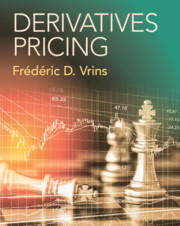49 results
Hedging Comes to Latin America: Gauging Brazil’s Coping Strategies vis-à-vis the Sino-US Peer Competition
-
- Journal:
- Journal of Latin American Studies , First View
- Published online by Cambridge University Press:
- 24 March 2025, pp. 1-28
-
- Article
- Export citation

Derivatives Pricing
- Coming soon
-
- Expected online publication date:
- March 2025
- Print publication:
- 20 March 2025
-
- Textbook
- Export citation
Belief elicitation in experiments: is there a hedging problem?
-
- Journal:
- Experimental Economics / Volume 13 / Issue 4 / December 2010
- Published online by Cambridge University Press:
- 14 March 2025, pp. 412-438
-
- Article
- Export citation
Better safe than sorry: Why great powers accommodate high-value hedgers
-
- Journal:
- Review of International Studies , First View
- Published online by Cambridge University Press:
- 07 November 2024, pp. 1-19
-
- Article
-
- You have access
- Open access
- HTML
- Export citation
Managing the shortfall risk of target date funds by overfunding
-
- Journal:
- Journal of Pension Economics & Finance / Volume 24 / Issue 2 / April 2025
- Published online by Cambridge University Press:
- 10 January 2024, pp. 256-280
-
- Article
-
- You have access
- HTML
- Export citation
9 - Risks, Crises, and International Firms
- from Part III - International Organisation
-
- Book:
- International Economics and Business
- Published online:
- 21 December 2023
- Print publication:
- 21 December 2023, pp 239-264
-
- Chapter
- Export citation
Potential use of weather derivatives in hedging aggregate viticulture yields: An analysis of the Niagara region of Canada
-
- Journal:
- Journal of Wine Economics / Volume 18 / Issue 2 / May 2023
- Published online by Cambridge University Press:
- 15 November 2023, pp. 97-121
-
- Article
-
- You have access
- Open access
- HTML
- Export citation

After Hedging
- Hard Choices for the Indo-Pacific States Between the US and China
-
- Published online:
- 08 September 2023
- Print publication:
- 05 October 2023
-
- Element
-
- You have access
- Open access
- HTML
- Export citation
4 - How a Fiat Standard Works
-
- Book:
- Better Money
- Published online:
- 16 March 2023
- Print publication:
- 23 March 2023, pp 121-152
-
- Chapter
- Export citation
High-stakes hedges are misunderstood too. A commentary on: “Valuing bets and hedges: Implications for the construct of risk preference”
-
- Journal:
- Judgment and Decision Making / Volume 14 / Issue 5 / September 2019
- Published online by Cambridge University Press:
- 01 January 2023, pp. 605-607
-
- Article
-
- You have access
- Open access
- HTML
- Export citation
Chapter 4 - Text as Interaction
- from Part II - The Expression of Im/Politeness
-
-
- Book:
- Politeness in Ancient Greek and Latin
- Published online:
- 08 September 2022
- Print publication:
- 08 September 2022, pp 103-126
-
- Chapter
- Export citation
Less-expensive long-term annuities linked to mortality, cash and equity
-
- Journal:
- Annals of Actuarial Science / Volume 17 / Issue 1 / March 2023
- Published online by Cambridge University Press:
- 28 July 2022, pp. 170-207
-
- Article
-
- You have access
- Open access
- HTML
- Export citation
19 - A General Jump-Diffusion Model
- from Part V - Applications in Financial Economics
-
- Book:
- Point Processes and Jump Diffusions
- Published online:
- 27 May 2021
- Print publication:
- 17 June 2021, pp 206-219
-
- Chapter
- Export citation
16 - Basic Arbitrage Theory
- from Part V - Applications in Financial Economics
-
- Book:
- Point Processes and Jump Diffusions
- Published online:
- 27 May 2021
- Print publication:
- 17 June 2021, pp 173-187
-
- Chapter
- Export citation
17 - Poisson-Driven Stock Prices
- from Part V - Applications in Financial Economics
-
- Book:
- Point Processes and Jump Diffusions
- Published online:
- 27 May 2021
- Print publication:
- 17 June 2021, pp 188-197
-
- Chapter
- Export citation
18 - The Simplest Jump-Diffusion Model
- from Part V - Applications in Financial Economics
-
- Book:
- Point Processes and Jump Diffusions
- Published online:
- 27 May 2021
- Print publication:
- 17 June 2021, pp 198-205
-
- Chapter
- Export citation
Bet against yourself: integrating insurance and entrepreneurship
-
- Journal:
- Journal of Institutional Economics / Volume 17 / Issue 6 / December 2021
- Published online by Cambridge University Press:
- 25 May 2021, pp. 959-972
-
- Article
- Export citation
Marking one’s own viewpoint: The Finnish evidential verb+kseni ‘as far as I understand’ construction
-
- Journal:
- Nordic Journal of Linguistics / Volume 44 / Issue 3 / December 2021
- Published online by Cambridge University Press:
- 23 December 2020, pp. 255-280
-
- Article
- Export citation
7 - Commodity Exchanges, Commodity Investments and Speculation
-
- Book:
- A Handbook of Primary Commodities in the Global Economy
- Published online:
- 06 November 2020
- Print publication:
- 26 November 2020, pp 130-160
-
- Chapter
- Export citation
VALUATION OF HYBRID FINANCIAL AND ACTUARIAL PRODUCTS IN LIFE INSURANCE BY A NOVEL THREE-STEP METHOD
-
- Journal:
- ASTIN Bulletin: The Journal of the IAA / Volume 50 / Issue 3 / September 2020
- Published online by Cambridge University Press:
- 14 August 2020, pp. 709-742
- Print publication:
- September 2020
-
- Article
-
- You have access
- Open access
- Export citation


